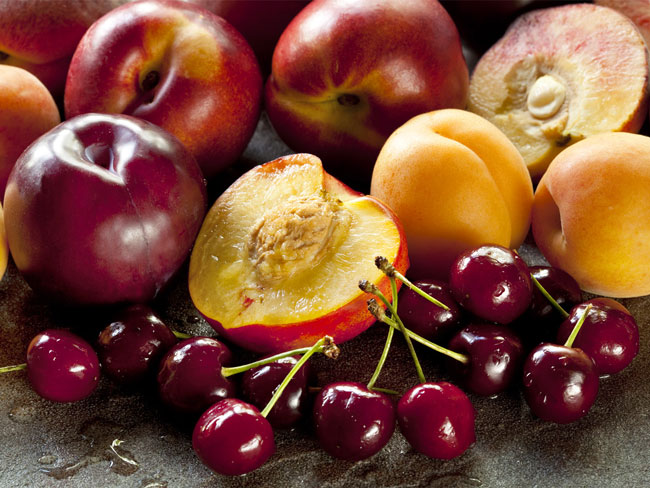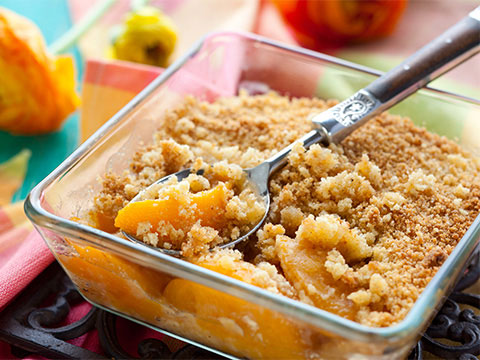Stone Fruit 101
- By T.J. Ford
- Last Updated On
- Reading Time: 4 mins.
 Biting into a warm, ripe peach and feeling the sweet juice dribble down your chin is one of the hallmarks of summer. Or perhaps you’re savoring a hot slice of nectarine and blueberry pie? Fresh from the tree, cut into salads, or baked into pies, crisps, or cobblers, nothing says summer like stone fruits.
Biting into a warm, ripe peach and feeling the sweet juice dribble down your chin is one of the hallmarks of summer. Or perhaps you’re savoring a hot slice of nectarine and blueberry pie? Fresh from the tree, cut into salads, or baked into pies, crisps, or cobblers, nothing says summer like stone fruits.
Cherries, peaches, plums, apricots, and their hybrids are called stone fruits because of the pits, or stones, at their center. They’re also classified botanically as drupes, which are fruits with a thin, edible outer skin, an edible flesh of varying thickness, and a hard stone enclosing a seed. The stone supports the fruit as it hangs off the tree by its stem and allows nutrients to move from the tree into the growing fruit.
Love stone fruit?
Check out our Harvest Mix.Popular Stone Fruits
Peaches
This ancient fruit has been around since 1000 BCE, having been grown first in China and Iran. The peach made its way to California by the 18th century and has been featured in summer picnics and pies ever since. Peaches are classified as either “clingstone,” meaning the flesh clings to the pit, or “freestone,” in which the stone is not attached to the flesh. This doesn’t affect the taste at all, but it’s easier to cut up freestone peaches if you’re using them in pies or cakes. Peaches have either white or yellow flesh. There is also the donut, or Saturn, peach, which is small and, well, donut-shaped.
Nectarines
Almost genetically identical to peaches, their skin is smooth rather than fuzzy. People who are sensitive to peach fuzz find that nectarines are an excellent replacement with a similar flavor.
Apricots
Since apricots are one of the more delicate stone fruits, they’re often dried to extend their shelf life and make them easier to transport. However, fresh apricots have a rich, creamy, sweet texture that makes them worth seeking out. They also cook up deliciously into jams, jellies, and baked goods like scones or tarts.
Plums
Most of the plums we eat in the U.S. are Asian or European varieties. Asian plums are larger and more rounded than their European cousins. Italian plums are becoming more popular for fresh eating, but they’re also delicious when dried—in which case we call them prunes.
Apriums
One of the several apricot-plum hybrids, apriums look, smell, and taste more like apricots, but they’re juicier, like a plum.
Pluots
These are a close relative of apriums but with a more complex and “plummy” fragrance and flavor.
Plumcots
Let’s not forget this variation, which is equal parts plum and apricot.
Cherries
These come in both sweet and sour varieties. The sweet ones, including Bing (red), Rainier (yellow), and Sweetheart (red and heart-shaped), are typically eaten fresh. Sour cherries, such as Morello and Montmorency, are most often used in juices, jellies, jams, and pies, or dried and used in other baked goods.
Ripening Stone Fruit
Stone fruits are usually picked when mature but not fully ripe; they continue to ripen off the tree. The fruit softens as it ripens, and the starches convert to sugars, making the fruit sweeter. Nectarines and white peaches are the quickest to ripen, with a very short shelf life. Ripe plums, yellow peaches, and apricots last three to five days in your fridge, and cherries can last up to a week. (Although frankly, in our house we’ve never been able to wait that long without eating every last one of them!)
If you want to speed up the ripening process, put your peaches or plums in a paper bag on the counter (not in the fridge) for about 24 hours. Washing fruits will also speed up the ripening process.
Nutrition
All stone fruits are high in vitamin C, which supports your immune system as well as encourages greater collagen production (meaning healthier skin and tissues). Additionally, the fiber in peaches and other stone fruits helps you feel full, so you’ll be less tempted to snack on less-healthy foods.
How to Enjoy
You can serve fresh stone fruits whole, sliced, or cut up in fruit salads. If you’re feeling more ambitious, a fruit crisp is a quick, delicious dessert that’s easily transported to your next picnic or outdoor party.
 Simple Peach Crisp
Simple Peach Crisp
INGREDIENTS
- ½ cup of all-purpose flour
- ¾ cup of brown sugar
- ½ teaspoon of ground cinnamon
- ¼ teaspoon of salt
- ½ cup of cold unsalted butter, cubed into small pieces
- One cup of old-fashioned rolled oats
For the filling:
- Five cups of sliced peaches (about six or seven medium peaches)
- ⅓ cup of granulated sugar
- ¼ cup of all-purpose flour
PREPARATION
- Preheat oven to 350℉. Butter and flour a 9-inch cake pan or a 9-inch square baking dish.
- In a bowl, whisk together flour, brown sugar, cinnamon, and salt. Add the cold cubed butter, and using a pastry cutter or two knives, cut the butter into the dry ingredients until the mixture starts to come together and is crumbly. Stir in the oats, and put the mixture into the refrigerator while you make the filling.
- To make the filling, put the peaches into a large bowl and sprinkle with the sugar and flour. Stir gently until all peaches are coated.
- Spoon the peaches into the prepared baking dish or pan, and evenly distribute the refrigerated filling over the top, covering the fruit.
- Bake the crisp for 40 to 45 minutes, or until the topping is lightly browned and the juices bubble around the edges of the pan. Remove from oven and cool slightly on a wire rack before serving.
- Top with whipped cream or ice cream!
T. J. Ford is a bodyworker and a health and nutrition coach who lives and runs in Portland, OR.
Be an office hero!
Get fruit for your office & remote employees.Recent Articles
Fresh From the Midwest: Lehman’s Orchard Grows Sweet Apples and More
Your Red Kiwi Guide: How It Compares to Its Colorful Cousins
Tasty Thanksgiving Recipes from The FruitGuys Team
The FruitGuys Ranks Among San Francisco’s Fastest-Growing Private Companies
Corporate Wellness Program Planning: Your 2026 Guide to a Healthier Workplace
Subscribe to our Newsletter
"*" indicates required fields



